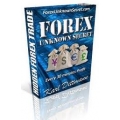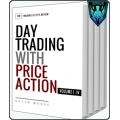Mark fisher the logical trader applying a method to the madness wiley
 Click to enlarge |
|
An in-depth look at the trading system that anyone can use
The Logical Trader presents a highly effective, yet simple trading methodology that any trader anywhere can use to trade almost anything. The "ACD Method" developed and refined by Mark Fisher after many years of successful trading, provides price points at which to buy and sell as determined by the opening range of virtually any stock or commodity.
This comprehensive guide details a widely used system that is profitably implemented by many computer and floor traders at major New York exchanges. The author's highly accessible teaching style provides readers of The Logical Trader with a full examination of the theory behind the ACD Method and the examples and real-world trading stories involving it.
Mark B. Fisher (New York, NY), an independent trader, is founder of MBF Clearing Corp., the largest clearing firm on the NYMEX. Founded in 1988, MBF Clearing has grown from handling under one percent of the volume on the NYMEX to nearly twenty percent of the trades today. A 1982 summa cum laude graduate from the Wharton School of Business, University of Pennsylvania, Fisher also received his master's degree in finance and accounting from Wharton.
New technology and the advent of around the clock trading have opened the floodgates to both foreign and domestic markets. Traders need the wisdom of industry veterans and the vision of innovators in today's volatile financial marketplace. The Wiley Trading series features books by traders who have survived the market's ever changing temperament and have prospered-some by reinventing systems, others by getting back to basics. Whether a novice trader, professional or somewhere in-between, these books will provide the advice and strategies needed to prosper today and well into the future.
Forword by Paul Tudor Jones.
Introduction.
Know Your ACDs.
The Pivot Concept.
Putting It Together: ACD and Pivot Ranges.
Macro ACD.
LOGICAL TRADER: MIDTERM.
Pivot Moving Averages.
The Advanced Trader.
The ACD Version of "Ripley's Believe It or Not!"
Trader Interviews.
Appendix.
Glossary.
Index.
summary form admin about this book:
The Logical Trader is not a "fluff" book on trading. Quite the contrary, it requires the reader to spend considerable time and effort to absorb and learn the methodology and principles provided by Mark Fisher, a master trader and teacher.
Over the last 15 years, Fisher, an independent trader, has taught his trading approach dubbed the "ACD" system to over 4,000 individuals including members of his clearing firm - which is the largest clearing firm for the NY Mercantile Exchange. Of the 1,000 traders who use Fisher's methodology, 10% make over $750,000 a year, according to Fisher.
This is certainly a testament to the soundness of Fisher's methodology. Fisher emphasizes that is method can be used to trade commodities, currencies, or stocks either at a trading firm, on the exchange floor, or at home. Traders taught by Fisher have had a 40 - 50% success rate compared to around 10 - 15% for the average trader using different techniques/
Fisher peppers his books with examples, anecdotes and stories. However, the main thrust is focused on explaining his ACD system in excruciating detail with numerous chart examples, detailed explanations of the key terms and trading parameters.
The ACD system - plotting price points in relation to the opening range - requires no expensive software. The method provides reference points for trading - A and C points are for entry and B and D are stops. Using the system the trader can calculate when to go long or short. Coupled with additional indicator and measurements, layered on top of the ACD system, the trader will be able to develop a trading plan.
To use the ACD system -which is based on simple math - the trader must have certain abilities including collect and analyze information, make and implement decisions, be good with numbers, be disciplined to follow the system. Fisher describes pivot points, the daily pivot price (high+low+close)/3), daily pivot range, 3-day rolling pivot, etc. The last 30 days data are viewed to obtain the big picture of the vehicle being traded. He calls this his Macro ACD. He provides 25 chart examples to illustrate how to score each day.
After the first four chapters, Fisher has an exam with answers to make sure that the reader understands all the key concepts and calculations.
Fisher adds more meat to the ACD system by introducing the use of pivot moving average (using daily pivot price as opposes to the day's close) to determine the current trend (up, down or flat).
He uses three pivot point moving averages (14 day, 30 day and 50 day) and focuses on looking at the slope of the moving average line to determine the existing trend or rate of change in the trend. Then Fisher covers exit strategies. He explains the rolling pivot range (RPR) which typically spans 3 to 6 trading days. This is the reference point for entry of the trade. The RPR let's you keep your winning position longer and gets you out of your losing positions in a more profitable manner. Fisher also calculates the price momentum of today's close compared to 8 days ago to determine the trend. He then discusses his use of the "reversal" trade set-up to exploit the market failures. Other subjects covered include the two-way swing, trend reversal trade and sushi roll (change in the direction of the market), and outside reversal week.
Fisher illustrates the effectiveness of using the ACD system using charts from the 1929 crash. It would have worked well in 1929 at the top and in 1932 at the market bottom in keeping the trader on the right side of the market.
Fisher devotes on 27-page chapter to real person trading stories focusing on risk management. Lastly, Fisher interviews seven traders that have successfully used his system with their personal perspectives.
The book contains a 10-page glossary of relevant terms, a table of 20 simple trading rules, and a 27-page compilation of sample data gathering for the ACD system.
In summary, this book requires a lot of time and study from the reader, but the potential rewards could be substantial

 Categories
Categories Information
Information Specials
Specials-38x38.jpg)





-38x38.jpg)

-38x38.jpg)
-38x38.jpg)
-38x38.jpg)
-38x38.jpg)
-38x38.jpg)

-38x38.jpg)



-38x38.jpg)


-38x38.jpg)
-38x38.jpg)
 Featured
Featured

























 Shopping Cart
Shopping Cart Bestsellers
Bestsellers-38x38.jpg)
-38x38.jpg)
-38x38.jpg)




-38x38.jpg)







-38x38.jpg)

-38x38.jpg)

















-38x38.jpg)









-120x120.jpg)
